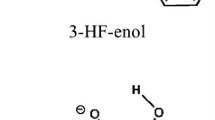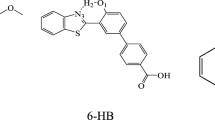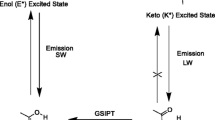Abstract
The photophysical properties of 5-(4-fluorophenyl)-2-hydroxypyridine (FP2HP) have been studied by steady state and time resolved spectroscopy in combination with quantum chemical calculations. The molecule FP2HP exists as lactim and lactam form in the ground state due to small stability difference but does not undergo lactim to lactam isomerisation due to high barrier energy. Whereas in the excited state the lactim form undergoes tautomerization producing red shifted emission of the lactam tautomer along with the local emission of the lactim form. In polar protic solvents, the barrier for lactim-lactam tautomerization rapidly decreases forming the lactam tautomer only. Temperature has pronounced effect on the excited state tautomerization equilibrium and is clearly reflected in the measured equilibrium constant (K 0tau ) and free energy change (ΔG0). Structural calculations at Hartree Fock and Density Functional Theory levels, calculated stability of the isomers in different solvents using Polarized Continuum Model and the theoretical potential energy surfaces for the ground and excited states along the proton transfer coordinate are reported for the tautomeric equilibrium of FP2HP.





Similar content being viewed by others
References
Parsapour F, Kelley DF (1996) Torsional and proton transfer dynamics in substituted 3-hydroxyflavones. J Phys Chem 100:2791–2798
Sytnik A, Kasha M (1994) Excited-state intramolecular proton transfer as a fluorescence probe for protein binding-site static polarity. Proc Natl Acad Sci USA 91:8627–8630
Kim S, Park SY (2003) Photochemically gated protonation effected by intramolecular hydrogen bonding: towards stable fluorescence imaging in polymer films. Adv Mater 15:1341–1344
Catalán J, del Valle JC, Claramunt RM, Sanz D, Dotor J (1996) Photophysics of the 2-(2′-hydroxyphenyl)perimidine: on the fluorescence of the enol form. J Lumin 68:165–170
Chou PT, McMorrow D, Aartsma TJ, Kasha M (1984) The proton-transfer laser. Gain spectrum and amplification of spontaneous emission of 3-hydroxyflavone. J Phys Chem 88:4596–4599
Acuna AV, Amat-Guerri F, Catalán J, Costella A, Figuera J, Munoz J (1986) Pulsed liquid lasers from proton transfer in the excited state. Chem Phys Lett 132:567–569
Sakai KI, Tsuzuki T, Itoh Y, Ichikawa M, Taniguchi Y (2003) Using proton-transfer laser dyes for organic laser diodes. Appl Phys Lett 86:081103
Roshal AD, Grigorovich AV, Doroshenko AO, Pivovarenko VG (1998) Flavonols and crown-flavonols as metal cation chelators. The different nature of Ba2+ and Mg2+ complexes. J Phys Chem A 102:5907–5914
Renschler CL, Harrah LA (1985) Reduction of reabsorption effects in scintillators by employing solutes with large stokes shifts. Nucl Instrum Methods Phys Res Sect A 235:41–45
Kim S, Seo J, Jung HK, Kim JJ, Park SY (2005) White luminescence from polymer thin films containing excited-state intramolecular proton-transfer dyes. Adv Mater 17:2077–2082
Weisstuch A, Neidig P, Testa AC (1975) Fluorescence study of hydroxypyridines. J Lumin 10:137–144
Abou-Zied OK, Al-Shihi OIK (2008) Characterization of subdomain IIA binding site of human serum albumin in its native, unfolded, and refolded states using small molecular probes. J Am Chem Soc 130:10793–10801
Nimlos MR, Kelly DF, Bernstein ER (1989) Spectroscopy, structure, and proton dynamics of 2-hydroxypyridine and its clusters with water and ammonia. J Phys Chem 93:643–651
Held A, Pratt DW (1993) Ammonia as a hydrogen bond donor and acceptor in the gas phase. Structures of 2-Pyridone-NH3 and 2-Pyridone-(NH& in Their SO and S1 Electronic States. J Am Chem Soc 115:9718–9723
Matsuda Y, Ebata T, Mikami N (2001) IR-UV double-resonance spectroscopic study of 2-Hydroxypyridine and its hydrogen-bonded clusters in supersonic jets. J Phys Chem A 105:3475–3480
Watson JD, Crick FHC (1953) Genetical implications of the structure of deoxyribonucleic acid. Nature 171:964–967
Topal MD, Fresco JR (1976) Complementary base pairing and the origin of substitution mutations. Nature 263:285–289
Mehler HR, Cordes EH (1971) Biological chemistry, 2nd edn. Harper and Row, New York
Pullman B, Oullman A (1971) Electronic aspects of purine tautomerism. Adv Heterocycl Chem 13:77–159
Scanlan MJ, Hillier IH (1984) On the mechanism of proton transfer in the 2-hydroxypyridine α 2-pyridone tautomeric equilibrium. Chem Phys Lett 107:330–332
Moreno M, Miller WH (1990) On the tautomerization reaction 2-pyridone 2-hydroxypyridine: an ab initio study. Chem Phys Lett 171:475–479
Sobolewski AL (1993) The mechanism of excited-state hydrogen transfer in 2-hydroxypyridine. Chem Phys Lett 211:293–299
Barone V, Adamo C (1994) A theoretical investigation of potential energy surfaces governing the photochemical tautomerization of 2-pyridone. Chem Phys Lett 226:399–404
Nowak MJ, Lapinski L, Fulara J, Les A, Adamowicz L (1992) Matrix isolation IR spectroscopy of tautomeric systems and its theoretical interpretation. 2-Hydroxypyridine/2(1 H)-Pyridinone. J Phys Chem 96:1562–1569
Kuzuya M, Noguchi A, Okuda T (1984) Fluorescence spectroscopic detection of the pyridinol form in tautomeric 2(1H)-pyridones. J Chem Soc Chem Commun 435–436
Sobolewski AL, Adamowicz L (1996) Photophysics of 2-Hydroxypyridine: an ab initio study. J Phys Chem 100:3933–3941
Church R, Trust R, Albright JD, Powell D (1995) New synthetic routes to 3-, 5-, and 6-Aryl-2-chloropyridines. J Org Chem 60:3750–3758
Mahata A, Sarkar D, Bose D, Ghosh D, Girigoswami A, Das P, Chattopadhyay N (2009) Photophysics and rotational dynamics of a β-Carboline analogue in nonionic micelles: effect of variation of length of the headgroup and the tail of the surfactant. J Phys Chem B 113:7517–7526
Frisch MJ et al (2003) Gaussian 03, Revision B.03, Gaussian, Inc. Pittsburgh, PA
Mahanta S, Singh RB, Kar S, Guchhait N (2006) Excited state intramolecular proton transfer in 3-hydroxy-2-naphthaldehyde: a combined study by absorption and emission spectroscopy and quantum chemical calculation. Chem Phys 324:742–752
Singh RB, Mahanta S, Kar S, Guchhait N (2007) Photo-physical properties of 1-hydroxy-2-naphthaldehyde: a combined fluorescence spectroscopy and quantum chemical calculations. Chem Phys 331:373–384
Prabhu AAM, Siva S, Sankaranarayanan RK, Rajendiran N (2010) Intramolecular proton transfer effects on 2, 6-diaminopyridine. J Fluoresc 20:43–54
Li QS, Fang WH, Yu JG (2005) Theoretical studies of proton-transfer reactions of 2-Hydroxypyridine − (H2O)n (n = 0 − 2) in the ground and excited states. J Phys Chem A 109:3983–3990
Paul BK, Mahanta S, Singh RB, Guchhait N (2010) A DFT-based theoretical study on the photophysics of 4-hydroxyacridine: single-water-mediated excited state proton transfer. J Phys Chem A 114:2618–2627
Formosinho SJ, Arnaut LG (1993) Excited-state proton transfer reactions II. Intramolecular reactions. J Photochem Photobiol A Chem 75:21–48
Justin K, Wu Y, Bredas J, Batista VS (2009) Quantum dynamics of the excited-state intramolecular proton transfer in 2-(2′-Hydroxyphenyl)benzothiazole. Isr J Chem 49:187–197
Schriever C, Barbatti M, Stock K, Aquino AJA, Tunega D, Lochbrunner S, Riedle E, de Vivie-Riedle R, Lischka H (2008) The interplay of skeletal deformations and ultrafast excited-state intramolecular proton transfer: experimental and theoretical investigation of 10-hydroxybenzo[h]quinoline. Chem Phys 347:446–461
Acknowledgement
NG acknowledges DST, India (Project No. Project No. SR/S1/PC/26/2008) and CSIR, India (Project no. 01(2161)07/EMR-II) for financial support and AS and BKP thanks CSIR, New Delhi, for Senior Research Fellowship. The authors are thankful to Dr. Nitin Chattopadhyay of Jadavpur University, Kolkata, for allowing them to use fluorescence lifetime measurement set-up.
Author information
Authors and Affiliations
Corresponding author
Rights and permissions
About this article
Cite this article
Samanta, A., Paul, B.K., Kar, S. et al. Excited State Lactim to Lactam Type Tautomerization Reaction in 5-(4-Fluorophenyl)-2-Hydroxypyridine: Spectroscopic Study and Quantum Chemical Calculation. J Fluoresc 21, 95–104 (2011). https://doi.org/10.1007/s10895-010-0692-3
Received:
Accepted:
Published:
Issue Date:
DOI: https://doi.org/10.1007/s10895-010-0692-3




